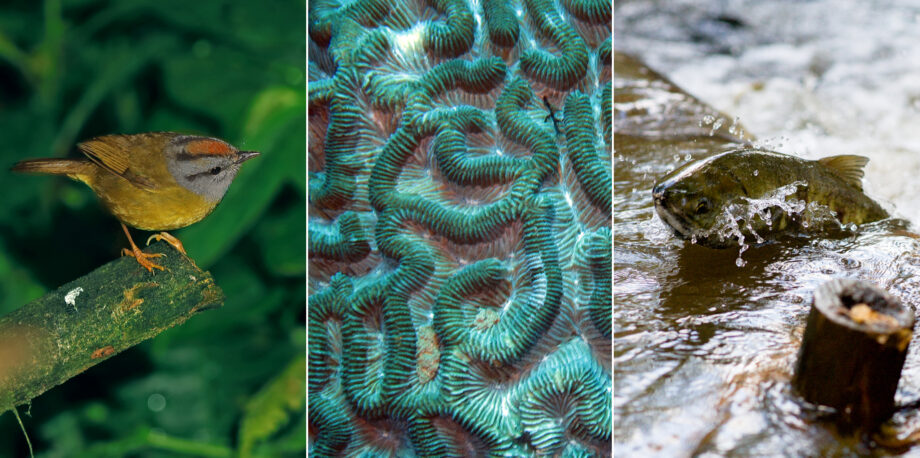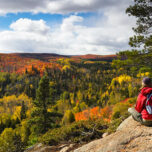July 21, 2020 — Caribbean corals sprout off Texas. Pacific salmon tour the Canadian Arctic. Peruvian lowland birds nest at higher elevations.
In the past 100 years, the planet has warmed in the range of 10 times faster than it did on average over the past 5,000. In response, thousands of species are traveling poleward, climbing to higher elevations, and diving deeper into the seas, seeking their preferred environmental conditions. This great migration is challenging traditional ideas about native species, the role of conservation biology and what kind of environment is desirable for the future.
In a 2017 review for Science, University of Tasmania marine ecology professor Gretta Pecl and colleagues wrote, “[C]limate change is impelling a universal redistribution of life on Earth. For marine, freshwater, and terrestrial species alike, the first response to changing climate is often a shift in location.” In fact, Pecl says, data suggest that at least 25% and perhaps as much as 85% of Earth’s estimated 8.7 million species are already shifting ranges in response to climate change.
But when they arrive, will they be welcome? Traditional definitions classify species according to place. “Native” species arrived without human help and usually before widespread human colonization, so are likely to have natural predators and are unlikely to go rogue. Non-natives are newcomers and suspect. Though 90% cause no lasting damage, 10% become invasive — meaning that they harm the environment, the economy or human health. Last year a multinational report flagged invasive species as a key driver of Earth’s biodiversity crisis.
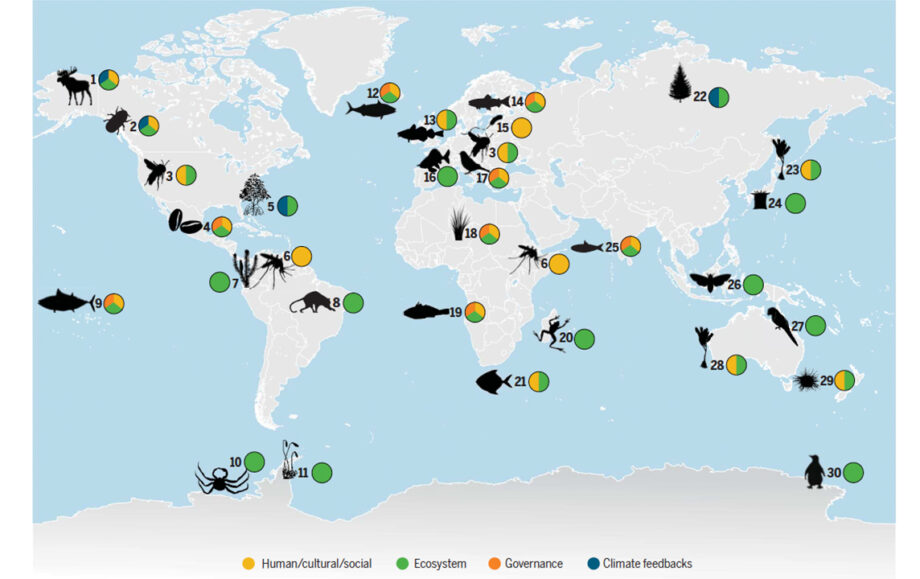
Known and anticipated changes in species distribution due to climate change around the world have implications for culture, society ecosystems, governance and climate change. Figure used with permission from Gretta T. Pecl, originally published on 31 Mar 2017 in Science 355(6332). Click image to expand.
How we define species is critical, because these definitions influence perceptions, policy and management. The U.S. National Invasive Species Council (NISC) defines a biological invasion as “the process by which non-native species breach biogeographical barriers and extend their range” and states that “preventing the introduction of potentially harmful organisms is … the first line of defense.” But some say excluding newcomers is myopic.
“If you were trying to maintain the status quo, so every time a new species comes in, you chuck it out,” says Camille Parmesan, director of the French National Centre for Scientific Research, you could gradually “lose so many that that ecosystem will lose its coherence.” If climate change is driving native species extinct, she says, “you need to allow new ones coming in to take over those same functions.”
As University of Florida conservation ecologist Brett Scheffers and Pecl warned in a 2019 paper in Nature Climate Change, “past management of redistributed species … has yielded mixed actions and results.” They concluded that “we cannot leave the fate of biodiversity critical to human survival to be randomly persecuted, protected or ignored.”
Existing Tools
One approach to managing these climate-driven habitat shifts, suggested by University of California, Irvine marine ecologist Piper Wallingford and colleagues in a recent issue of Nature Climate Change, is for scientists to adapt existing tools like the Environmental Impact Classification of Alien Taxa (EICAT) to assess potential risks associated with moving species. Because range-shifting species pose impacts to communities similar to those of species introduced by humans, the authors argue, new management strategies are unnecessary, and each new arrival can be evaluated on a case-by-case basis.
Karen Lips, a professor of biology at University of Maryland who was not associated with the study, echoes the idea that each case is so varied and nuanced that trying to fit climate shifting species into a single category with broad management goals may be impractical. “Things may be fine today, but add a new mosquito vector or add a new tick or a new disease, and all of a sudden things spiral out of control,” she says. “The nuance means that the answer to any particular problem might be pretty different.”
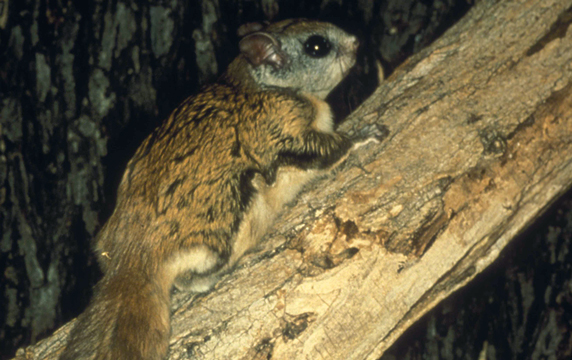
In recent years, northern flying squirrels in Canada have found themselves in the company of new neighbors — southern flying squirrels expanding their range as the climate warms. Public Domain | USFW
Laura Meyerson, a professor in the Department of Natural Resources Science at the University of Rhode Island says scientists should use existing tools to identify and address invasive species to deal with climate-shifting species. “I would like to operate under the precautionary principle and then reevaluate as things shift. You’re sort of shifting one piece in this machinery; as you insert a new species into a system, everything is going to respond,” she says. “Will some of the species that are expanding their ranges because of climate change become problematic? Perhaps they might.”
The reality is that some climate-shifting species may be harmful to some conservation or economic goals while being helpful to others. While sport fisherman are excited about red snapper moving down the East Coast of Australia, for example, if they eat juvenile lobsters in Tasmania they could harm this environmentally and economically important crustacean. “At the end of the day … you’re going to have to look at whether that range expansion has some sort of impact and presumably be more concerned about the negative impacts,” says NISC executive director Stas Burgiel. “Many of the [risk assessment] tools we have are set up to look at negative impact.” As a result, positive effects may be deemphasized or overlooked. “So that notion of cost versus benefit … I don’t think it has played out in this particular context.”
Location, Location, Location
In a companion paper to Wallingford’s, University of Connecticut ecology and evolutionary biology associate professor Mark Urban stressed key differences between invasive species, which are both non-native and harmful, and what he calls “climate tracking species.” Whereas invasive species originate from places very unlike the communities they overtake, he says, climate tracking species expand from largely similar environments, seeking to follow preferred conditions as these environments move. For example, an American pika may relocate to a higher mountain elevation, or a marbled salamander might expand its New England range northward to seek cooler temperatures, but these new locations are not drastically different than the places they had called home before.
Climate tracking species may move faster than their competitors at first, Urban says, but competing species will likely catch up. “Applying perspectives from invasion biology to climate-tracking species … arbitrarily chooses local winners over colonizing losers,” he writes.
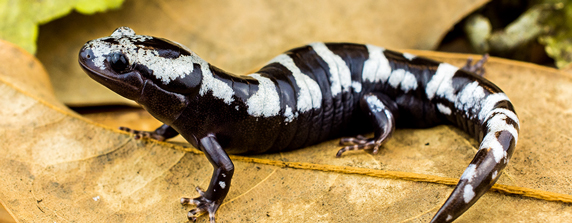
The marbled salamander, a native of the eastern U.S., is among species whose range could expand northward to accommodate rising temperatures. Photo courtesy of Seánín Óg from Flickr, licensed under CC BY-NC-ND 2.0
Urban stresses that if people prevent range shifts, some climate-tracking species may have nowhere to go. He suggests that humans should even facilitate movement as the planet warms. “The goal in this crazy warming world is to keep everything alive. But it may not be in the same place,” Urban says.
Parmesan echoes Urban, emphasizing it’s the distance that makes the difference. “[Invasives] come from a different continent or a different ocean. You’re having these enormous trans-global movements and that’s what ends up causing the species that’s exotic to be invasive,” she says. “Things moving around with climate change is a few hundred miles. Invasive species are moving a few thousand miles.”
In 2019 University of Vienna conservation biology associate professor Franz Essl published a similar argument for species classification beyond the native/non-native dichotomy. Essl uses “neonatives” to refer to species that have expanded outside their native areas and established populations because of climate change but not direct human agency. He argues that these species should be considered as native in their new range.
They Never Come Alone
Meyerson calls for caution. “I don’t think we should be introducing species” into ecosystems, she says. “I mean, they never come alone. They bring all their friends, their microflora, and maybe parasites and things clinging to their roots or their leaves. … It’s like bringing some mattress off the street into your house.”
Burgiel warns that labeling can have unintended consequences. We in the invasive species field … focus on non-native species that cause harm,” he says. “Some people think that anything that’s not native is invasive, which isn’t necessarily the case.” Because resources are limited and land management and conservation are publicly funded, Burgiel says, it is critical that the public understands how the decisions are being made.
Piero Genovesi, chair of the International Union for the Conservation of Nature’s Invasive Species Specialist Group, sees the debate about classification — and therefore about management — as a potential distraction from more pressing conservation issues.
“The real bulk of conservation is that we want to focus on the narrow proportion of alien species that are really harmful,” he says. In Hawaii “we don’t discuss species that are there [but aren’t] causing any problem because we don’t even have the energy for dealing with them all. And I can tell you, no one wants to remove [non-native] cypresses from Tuscany. So, I think that some of the discussions are probably not so real in the work that we do in conservation.”
Indigenous frameworks offer another way to look at species searching for a new home in the face of climate change. According to a study published in Sustainability Science in 2018 by Dartmouth Native American studies and environmental studies associate professor Nicholas Reo, a citizen of the Sault Ste. Marie Tribe of Chippewa Indians, and Dartmouth anthropology associate professor Laura Ogden, some Anishnaabe people view plants as persons and the arrival of new plants as a natural form of migration, which is not inherently good or bad. They may seek to discover the purpose of new species, at times with animals as their teachers. In their paper Reo and Ogden quote Anishnaabe tribal chairman Aaron Payment as saying, “We are an extension of our natural environment; we’re not separate from it.”
The Need for Collaboration
The successful conservation of Earth’s species in a way that keeps biodiversity functional and healthy will likely depend on collaboration. Without global agreements, one can envision scenarios in which countries try to impede high-value species from moving beyond their borders, or newly arriving species are quickly overharvested.
In Nature Climate Change, Sheffers and Pecl call for a Climate Change Redistribution Treaty that would recognize species redistribution beyond political boundaries and establish governance to deal with it. Treaties already in place, such as the Convention on International Trade in Endangered Species of Wild Fauna and Flora, which regulates trade in wild plants and animals; the Migratory Bird Treaty Act; and the Agreed Measures for the Conservation of Antarctic Fauna and Flora, can help guide these new agreements.
“We are living through the greatest redistribution of life on Earth for … potentially hundreds of thousands of years, so we definitely need to think about how we want to manage that,” Pecl says.
At the heart of these questions are values. Genovesi agrees that conservationists need a vision for the future. “What we do is more to be reactive [to known threats]. … It’s so simple to say that destroying the Amazon is probably not a good idea that you don’t need to think of a step ahead of that.” But, he adds, “I don’t think we have a real answer in terms of okay, this is a threshold of species, or this is the temporal line where we should aim to.” Defining a vision for what success would look like, Genovesi says, “is a question that hasn’t been addressed enough by science and by decision makers.”
At the heart of these questions are values. “All of these perceptions around what’s good and what’s bad, all [are based on] some kind of value system,” Pecl says. “As a whole society, we haven’t talked about what we value and who gets to say what’s of value and what isn’t.”
This is especially important when it comes to marginalized voices, and Pecl says she is concerned because she doesn’t “think we have enough consideration or representation of Indigenous worldviews.” Reo and colleagues wrote in American Indian Quarterly in 2017 that climate change literature and media coverage tend to portray native people as vulnerable and without agency. Yet, says Pecl, “The regions of the world where [biodiversity and ecosystems] are either not declining or are declining at a much slower rate are Indigenous controlled” — suggesting that Indigenous people have potentially managed species more effectively in the past, and may be able to manage changing species distributions in a way that could be informative to others working on these issues.
Meanwhile, researchers such as Lips see species classification as native or other as stemming from a perspective that there is a better environmental time and place to return to. “There is no pristine, there’s no way to go back,” says Lips. “The entire world is always very dynamic and changing. And I think it’s a better idea to consider just simply what is it that we do want, and let’s work on that.”
UPDATED 07.30.20: Nicholas Reo’s title was corrected.
Related Posts
Ensia shares solutions-focused stories free of charge through our online magazine and partner media. That means audiences around the world have ready access to stories that can — and do — help them shape a better future. If you value our work, please show your support today.
Yes, I'll support Ensia!